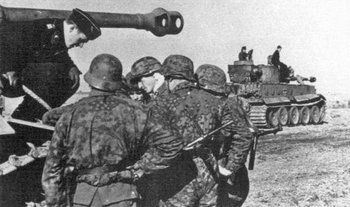
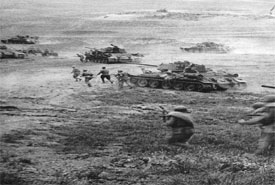
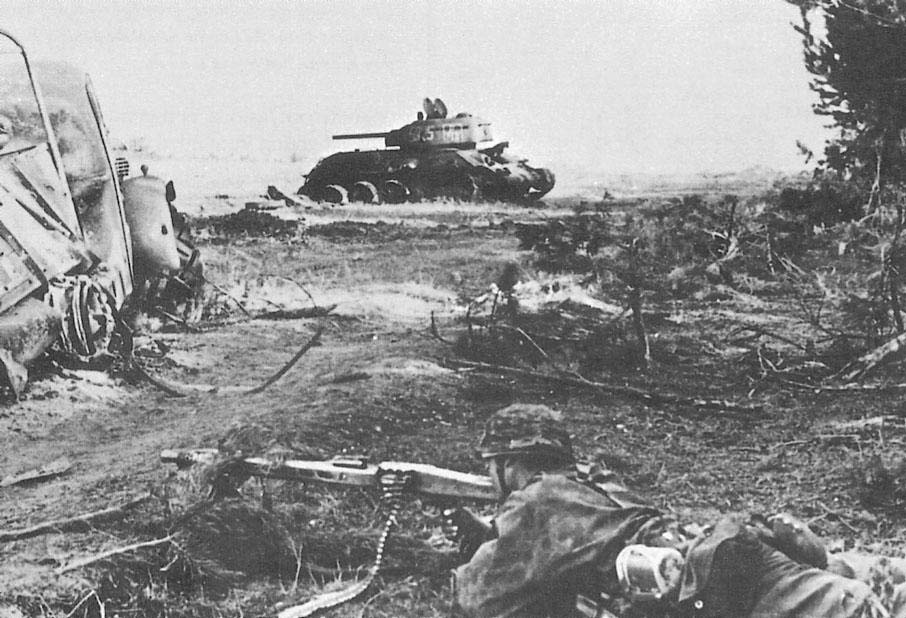
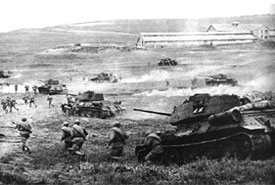
Horrific thunder... Kursk
July 1943 marked one of the shortest, but greatest tank battle in the history of mankind, and a great turning point in fight for liberation of Europe




In July 1943, after the battle of Stalingrad, German army found its self in retreat, and morale started to fall, but with better weather Hitler knew that he had to regain the initiative that the German troops had on the eastern front. As it would turn out this battle would decide the faith of the Red Army and the Nazi forces not only on the east but on other fronts in Europe as well. Hitler launched the so called Operation Zitadelle. Hitler wanted to mount a great attack on the small town of Kursk, and meat the Russian tanks there. It was also supposed to regain the confidence of the German people, and soldiers in the Nazi forces, but Hitler had his doubts. The great German strategist, Heinz Guderian, even asked Hitler if it was needed to attack Kursk, and the Russians that year at all, to which Hitler replied that the thought of it turns his stomach. Still Hitler didn't want to listen, and decided to go on with the attack. Colonel-General Kurtz Zeitzler was one of those who supported Hitler, and considered this to be the next logical step after the fall of Kharkov in March that year.
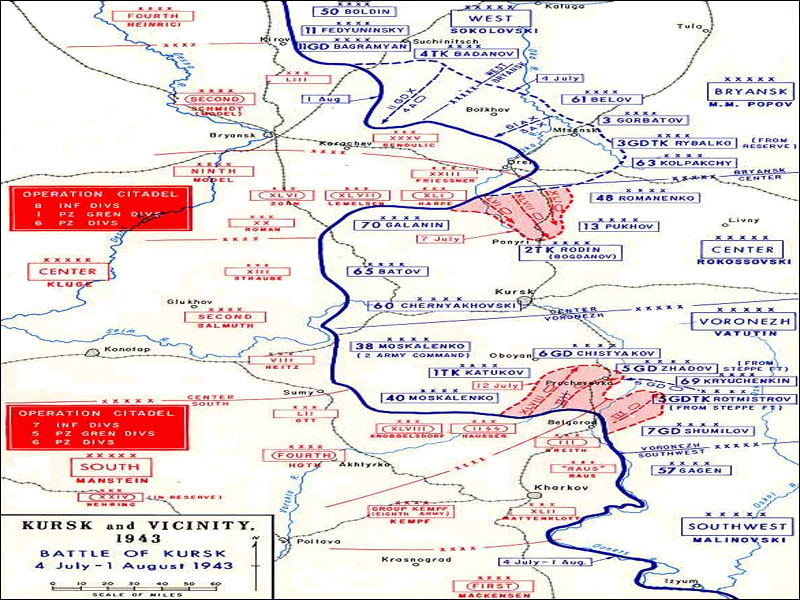
The Germans started massing up armor around the city of Kursk, and to the south of Kursk was the town of Belgorod. Commanding the German army was Erich von Manstein and the Russian troops were commanded by Nikolai Vatutin, and Nikolai Rokossovsky, with Marshal Zukov overlooking the battle. The Russians saw the massive build up in Nazi armor, their intelligence data also revealed that an offensive was about to be mounted in this region, and the British intelligence intercepted German messages, and sent this information to Stalin. The Red Army also saw this as the next step in the German offensive, and started to prepare for a horrifying clash with the German Panzer divisions. Stallin wanted to launch an offensive on the Germans but Marshal Zukov, who gained huge authority after the battle of Stalingrad, and respect from those who served to him, and from the Stalin him self, insisted that the Germans attack first. The reason for this was in brilliant employment of tactics by Zukov, and the building of defensive positions around the city of Kursk. Stallin eventually agreed, and let Zukov take matters in his own hands. Zukov soon employed about 300000 on the front line to work on defenses, dig trenches, mount tank traps, they positioned anti-tank guns, lay anti-tank mines, and brought a huge number of tanks, for what was about to be the largest clash of armor in the history of mankind. Russians brought an amazing number of 1300000 soldiers to the front line, 3600 tanks, 20000 guns, and 2400 aircraft. The Nazi troops numbered 900000 soldiers, 2700 tanks, and 2000 aircraft as well as 3 elite Waffen SS divisions. While the Germans had far superior tanks, aircraft, and better trained soldiers, the Russians on the other side had more tanks, soldiers, aircraft, and excellent anti-tank guns. Marshal Zukov was an excellent commander, and he employed tactics which like in the battle of Stalingrad, would prove to be invaluable. The original date for the offensive to take place was the 4th May 1943 but Hitler wanted to wait for the new Panther and Elephant tanks to be ready. June 12th was the next scheduled date but the collapse of the African front in Tunisia also delayed the start of the offensive for a further three weeks until July. In the night of July 3, 1943 10 engineers from the German army cleared an amazing number of 2700 mines from the mine fields that the Red Army laid. On the same night the Red Army captured a sapper of the 6th Infantry Division-Private Fermello after a skirmish, who informed the Soviets of the start time of the offensive which was to be at 3am on 5th July. In the Belgorod sector a Slovene sapper deserted and told the Soviets of the date and start time of the offensive confirming what they already knew. At 14:45 on 4th of July Stukas belonging to the five Ju 87D Gruppen of Luftflotte 4 started bombing the area around a town of Butovo, 2 miles long, and 500 yards deep. The attack lasted ten minutes and as the dive bombers turned for home German artillery and Nebelwerfers opened up on the Red Army positions. Hoth's III Panzer Korps advanced on the Soviet positions around Savidovka, Alekseyevka and Luchanino. At the same time at Butovo the Soviet 199th Guards Rifle Regiment were attacked by 3rd Battalion Panzer Grenadier Regiment in torrential rain and the high ground around Butovo was taken by 11th Panzer Division. To the west of Butovo the going proved tougher for the 3rd Panzer Division who met stiff Soviet resistance and did not secure their objectives until midnight. II SS Panzer Korps under the command of Paul Hausser used the "Panzerkiel" tactics spearheaded by heavily armored Tiger I tanks followed up by Panther, MK IV and MK III tanks. By the 6th July they had penetrated some twenty miles but had come under strong resistance. Losses were high too with the Leibstandarte for example losing on the first day of action, 97 men killed and 522 men wounded. II SS Panzer Korps continued on towards the town of Prokhorovka with the 3rd SS Totenkopf leading the advance and dealing with all resistance to the west of the town. Their flank however was unprotected as Kempfs 6th,7th and 19th Panzer Divisions which belonged to III Panzer Korps were stalled by 7th Guards Army after crossing the River Donets. The 5th Guards Tank Army were situated to the east of the town of Prokhorovka and were preparing a counter attack when II SS Panzer Korps arrivedstarting a battle with elements of the 5th Guards Army being deployed to halt the Nazi troops advance. The Soviets knew that if III Panzer Korps broke out, the balance of armor would tip in the Germans favor. They decided to deploy the rest of the 5th Guards Tank Army to destroy the SS armored divisions. On July 12 the German Luftwaffe bombed Soviet positions and the SS Divisions formed up into their "Panzerkiel" formations. The SS Divisions were surprised to see a large number of Soviet tanks advancing towards them. The events that followed on that July 12th 1943 were to be recorded in history as the largest tank battle. The Germans had Tiger I tanks with their thick armor, and which proved them selves as far superior on the battle field than any other allied tanks, but they had only a few of these tanks, and most of the Nazi armor consisted of MK III and MK IV tanks which were not as good as the Tigers. Opposing the German tanks were the weaker T-34 and IS-1 tanks. The battle was fought at close range, which meant that although all German tanks were far superior in the thickness of their armor, and their protection, the Russians had an advantage in destroying the German tanks as shots were fired at almost point blank range and every hit at no matter how thich the armor was would mean a certain death for the tank crew. The battle was not fought on the ground, but in the sky as well, with German and Russian planes entering dog fights, but they couldn't target tanks on the ground because German and Russian tanks were too close to each other, and smoke from the guns, and the tanks that were destroyed covered the battlefield. Germans lost over 300 tanks, with the Russians loosing around that same number of tanks, but the Russians had the advantage in numbers. Although Russian tanks were poorly made, had lighter armor, and their shells could not penetrate as well as the German tank shells, the tactics that they used under the command of Marshal Zukov, and the fact that the battle was fought at close range with much more Russian tanks tipped the battle to the Russian nside, bringing them victory, and marking the last great offensive of the German army on the eastern front. Once again the Ktchusha artillery weapon proved to be one of the greatest weapons of the war significantly helping the Red Army win this battle. The new tanks had turned out to be very disappointing with most of the Mk V Panthers breaking down on the first day due to problems with the complex electrical cooling systems. From a total of 200 only 40 were in running order at the end of the first day. The Elephant tanks although having their 88mm guns had also proved a disappointment with Russian infantry simply attacking the 73 ton machines with Molotov cocktails when they were separated from the infantry with relative ease due to the absence of a hull machine gun as a secondary defenses. Although the German losses were high, the Russian losses were even greater, but the huge number of soldiers that the Red Army had at its disposal meant that the Russians could keep on fighting. Most of the casualties were suffered by the Russian 6th Guards Army. At the same time the allies were planning the invasion of Sicily after the defeat of Afrika Korps, and the great victory the allies have gained in Africa after the battle of El Alamein. This meant that some troops from the Eastern front would have to be transferred to Sicily to reinforce the defenses there, weakening the German positions on the eastern front. When the Allies landed in Sicily Hitler called von Kluge and Manstein to his headquarters and declared that he was calling Operation Zitadelle off. von Manstein was furious and argued that one final effort and the battle could be won. Hitler would have none of it particularly as the Soviets had launched a new counter offensive in the Orel sector.
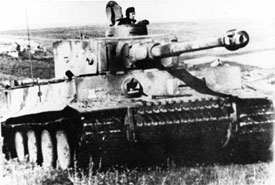
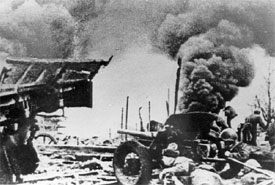
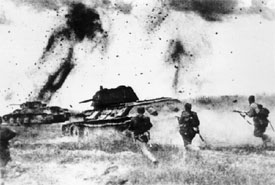
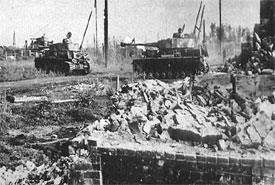
On the 15th July, Rokossovsky's Central Front struck at the Orel bulge and by 5th August Orel was liberated. The Germans withdrew to the partly prepared Hagen line at the base of the salient. To the south of Kursk the Russians re-grouped and by 3rd August another offensive opened up and Belgorod was liberated on the same day as Orel. The attack forced a 40-mile gap in Army Group South between 4th Panzer Army and Army Detachment Kempf. On the 11th August the last battle of Kharkov began and by 20th August the Germans were forced to withdraw. The Germans from then on would be fighting defensive battles all the way back to the frontiers of the Reich and into the Reich itself. The total number of losses for the whole offensive were put at 100,000 men killed or wounded. The Soviet casualty figures were not released until the end of the communist regime in the USSR and were recorded at 250,000 killed and 600,000 wounded. They also lost 50% of their tank strength.
The Russian defenders at Kursk helped the allied forces in the South and to the west, and ultimately forced the withdrawal of the Nazi troops, leading to victory and liberation of Europe from the Nazi oppression.
Web site made by Igor Radisic from Belgrade, Serbia & Montenegro. E-mail: [email protected]
60 years later... D-day | Bloody city... Stalingrad | Blue grave... Pearl Harbor | A bridge too far... Operation Marketgarden | Dust in the wind... El Alamein
© Copyright protected. All rights reserved. Igor Radisic 2004 - 2005